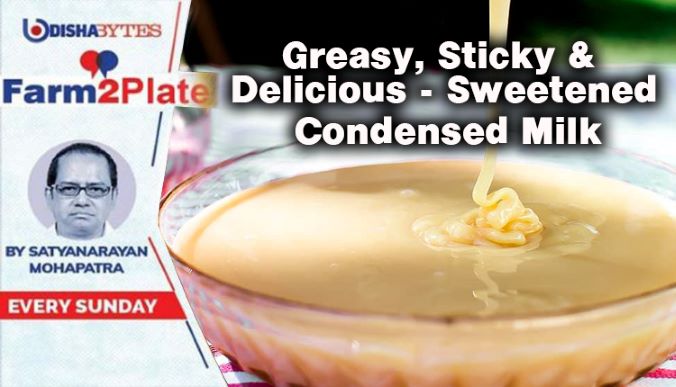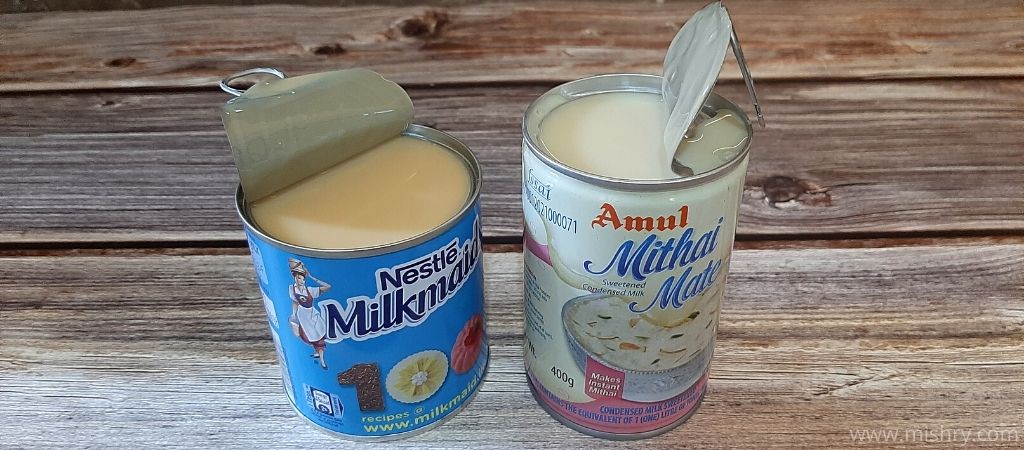Greasy, Sticky & Delicious — Sweetened Condensed Milk

Condensed milk, a popular tinned product, gave us immense pleasure when the yellow stuff spurted out during the easy-peasy act of puncturing. Condensed milk, whether from Nestle or Amul stable, cannot be visualised without a tin.
For centuries, milk did not reliably promise vitality to its drinkers. Milk in India was unsafe and unreliable, especially in urban areas. Transporting milk under the scorching tropical sun, often in open cans, made it more unusable. Adulteration was also a concern, due to hygiene factors. India’s dairying tradition was mainly a home-based business. The bulk of milk would be fermented to make buttermilk and yoghurt, or thicken it to make khoya or mawa, or turn it into ghee. Drinking fresh milk, especially cow milk, was not as common it seems in a world with pasteurisation.
Towards the end of 19th century, the British in India decided to redress this by setting up military dairy farms that would produce milk, cream and butter for soldiers and their families. But that didn’t help the majority of European civilians living in cities across the subcontinent. For them, fresh milk was either expensive or just dangerous. The answer to their problems arrived in the form of an unctuous, sticky and delicious substance – condensed milk.
Going back in history, Mahatma Gandhi in a letter written in August 1926 to Prabha Shankar Pattani advised him on how to get milk supply on a long ship journey. The first option was to keep sterilized milk in the ship’s ice chamber, and another option was to take along a few goats. If these two options did not work, it would be Nestle’s condensed milk.
Gandhi used condensed milk as a student in London, as he found it to be more convenient to use for tea. During his stay in Tolstoy Farm in South Africa, he used condensed milk regularly as an option to fresh milk.
Before the development of pasteurisation in the 1860s, raw milk would spoil so fast that it was probably safer not to drink it. Gail Borden apparently learned this hard truth on a ship journey back from England in 1851 when the milk on board went so bad that it killed many passengers. To deal with this, he came up with the idea of reducing milk and adding sugar, which preserves the milk just like the fruit in jam, with its hygroscopic action disarming microbes by dehydrating them.
Evaporated milk and condensed milk are both types of thick, concentrated milk that about 60% of the water has been removed from. However, there are a few notable differences between these common pantry staples.
Evaporated milk is a shelf-stable, concentrated form of milk sold in cans. Evaporated milk was developed in the 1890s, shortly after the invention of sweetened condensed milk. It is made by heating milk at reduced pressure until the water content has decreased by about half. Evaporated milk is sterilized after it is reduced and homogenized. As a shelf-stable alternative to fresh milk, evaporated milk was designed to be diluted with an equal amount of water. Evaporated milk is used in desserts like ice cream, cheesecake and puddings.
Condensed milk, also called sweetened condensed milk (there is no unsweetened condensed milk), is a concentrated milk product made by heating cow milk at reduced pressure. The milk is heated until the water content has reduced by half, then sugar is added to bring the sugar content up to 55%.
Canned sweetened condensed milk was developed in 1861, but the history of cooking fresh milk with sweeteners to increase its stability goes back thousands of years to Indian milk sweets known as mithai.
After Independence, Amul started developing its own brand, but one incident changed the entire scenario of condensed milk in India. As the story goes, Nestlé had a licence to make condensed milk in India, but the government discovered that instead of using Indian milk and sugar, it was importing everything.

Kurien was sent to Nestlé headquarters in Switzerland where he was told that condensed milk could not be made from buffalo milk available in India. Even if the company set up a plant, it would have to be staffed by foreigners since the procedure was so delicate it “could not leave it for the natives to make.”
Kurien exploded when he heard this and marched back to India, determined to make condensed milk at Amul. This did prove to be difficult since buffalo milk, the basis of Amul’s milk revolution, is much higher in lactose sugar than cow milk, and when regular sugar is added, the lactose tends to form large molecules with the sucrose of sugar, which gives the condensed milk an unpleasant gritty taste.
Amul finally cracked the formula and Kurien had the pleasure of demonstrating this to the same Nestlé official, forcing him to apologise for belittling Indian expertise. Amul’s Mithai Mate is now available in the market, in a more slender tin than Nestlé.
There’s a slight difference in taste. Milkmaid is more immediately sweet, with a strong front of palate flavour, and seems more rounded, but also slightly chalky; Mithai Mate’s sweetness comes a bit later and at the back of the throat, with a lingering richness.
A point worth noting is that neither Nestle nor Amul may be the largest producer of condensed milk in India. It is probably Cadbury’s, which makes and uses vast amounts of condensed milk to make ‘chocolate crumb’, a Cadbury’s invented product that is the basis of all their chocolate.
A potent thickener, condensed milk, poured straight out of a can, helped cut down on labour involved in preparing intricate sweetmeats, while adding more finesse to homely preparations. Condensed milk’s versatility, and the nostalgia it evokes, keeps it relevant in some Indian kitchens and among neophiles experimenting with food. But its original use as a shelf-stable substitute for milk was reflected in the rise in sales during the coronavirus-induced lockdowns.
For the Road: I remember my paternal grandma used to make a concoction of milk and sugar candy and put it on the ‘chulha’ after all meals were cooked at night. The milk in the morning used to be cooked into a subtle yellow colour and we all used to yearn for more.
This has always intrigued me — did our forefathers know about the ‘sweetened condensed milk’ but never documented it?

Comments are closed.